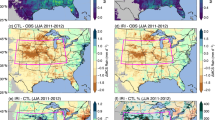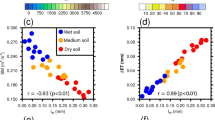Abstract
The impacts of irrigation on southeast United States diurnal climate are investigated using simulations from a regional climate model. An extreme case is assumed, wherein irrigation is set to 100 % of field capacity over the growing season of May through October. Irrigation is applied to the root zone layers of 10–40 and 40–100 cm soil layers only. It is found that in this regime there is a pronounced decrease in monthly averaged temperatures in irrigated regions across all months. In non-irrigated areas a slight warming is simulated. Diurnal maximum temperatures in irrigated areas warm, while diurnal minimum temperatures cool. The daytime warming is attributed to an increase in shortwave flux at the surface owing to diminished low cloud cover. Nighttime and daily mean cooling result as a consequence repartitioning of energy into latent heat flux over sensible heat flux, and of a higher net downward ground heat flux. Excess heat is transported into the deep soil layer, preventing a rapidly intensifying positive feedback loop. Both diurnal and monthly average precipitations are reduced over irrigated areas at a magnitude and spatial pattern similar to one another. Due to the excess moisture availability, evaporation is seen to increase, but this is nearly balanced by a corresponding reduction in sensible heat flux. Concomitant with additional moisture availability is an increase in both transient and stationary moisture flux convergences. However, despite the increase, there is a large-scale stabilization of the atmosphere stemming from a cooled surface.













Similar content being viewed by others
References
Bastola S, Misra V (2013) Sensitivity of hydrological simulations of southeastern United States watersheds to temporal aggregation of rainfalls. J Hydrometeorol 14:1334–1344
Biggs W, Graves M (1962) A lake breeze index. J Appl Meteorol Climatol 1:474–480
Braganza K, Karoly D, Arblaster JM (2004) Diurnal temperature range as an index of global climate change during the twentieth century. Geophys Res Lett. doi:10.1029/2004GL019998
Byers H, Rodebush H (1948) Causes of thunderstorms of the Florida peninsula. J Meteorol 5:275–280
Carbone RE, Tuttle JD (2008) Rainfall occurrence in the US warm season: the diurnal cycle. J Clim 21:4132–4146
Chan S, Misra V (2010) A diagnosis of the 1979–2005 extreme rainfall events in the southeastern United States with isentropic moisture tracing. Mon Weather Rev 138:1172–1185
Chow KC, Chan JCL (2010) Diurnal variations of circulation and precipitation in the vicinity of the Tibetan Plateau in early summer. Clim Dyn 32:55–73
Cosgrove B et al (2003) Real-time and retrospective forcing in the North American land data assimilation system (NLDAS) project. J Geophys Res. doi:10.1029/2002JD003118
Dai A, Trenberth KE (2004) The diurnal cycle and its depiction in the community climate system model. J Clim 17:931–951
Dai A, Girgi F, Trenberth KE (1999) Observed and model-simulated diurnal cycles of precipitation over the contiguous United States. J Geophys Res 104:6377–6402
Defries R, Bounoua L, Collatz G (2002) Human modification of the landscape and surface in the next fifty years. Glob Change Biol 8:438–458
Dinapoli S, Misra V (2012) Reconstructing the 20th century high-resolution climate of the southeastern United States. J Geophys Res. doi:10.1029/2012JD018303
Dirmeyer PA et al (2012) Simulating the diurnal cycle of rainfall in global climate models: resolution versus parameterization. Clim Dyn 39:399–418
Ek MB, Mitchell KE, Lin Y, Rogers E, Grunmann P, Koren V, Gayno G, Tarpley JD (2003) Implementation of Noah land surface model advances in the National Centers for Environmental Prediction operational mesoscale Eta model. J Geophys Res 108:8851
Evans JP, Westra S (2012) Investigating the mechanisms of diurnal rainfall variability using a regional climate model. J Clim 25:7232–7247
Gentry R, Moore P (1954) Relation of local and general wind interaction near the seas coast to time and location of air-mass showers. J Atmos Sci 11:507–511
Gibson H, Vonder Haar T (1990) Cloud and convection frequencies over the southeast United States as related to small-scale geographic features. Mon Weather Rev 118:2215–2227
Harding K, Snyder PK, Liess S (2013) Use of dynamical downscaling to improve the simulation of central US warm season precipitation in CMIP5 models. J Geophys Res 118:12522–12536
Hutson S, Barber N, Kenny J, Linsey K, Lumia D, Maupin M (2000) Estimated use of water in the United States in 2000. USGS circular 1268, revised Feb 2005
Kain J, Fritsch M (1993) Convective parameterization for mesoscale models: the Kain-Fritsch Scheme. J Appl Meteorol 43:170–181
Kanamaru H, Kanamitsu M (2007) Scale selective bias correction in a downscaling of global analysis using a regional model. Mon Weather Rev 135:334–350
Kanamaru H, Kanamitsu M (2008) Model diagnosis of nighttime minimum temperature warming during summer due to irrigation in the California Central Valley. J Hydrometall. doi:10.1175/2008JHM967.1
Kanamitsu M, Yoshimura K, Yhang Y, Hong S (2010) Errors of interannual variability and multi-decadal trend in dynamical regional climate downscaling and its corrections. J Geophys Res 115:D17115
Kanamitsu M, Ebisuzaki W, Woollen J, Yang S.-K, Hnilo JJ, Fiorino M, Potter GL (2002) NCEP-DOE AMIP-II Reanalysis (R-2). Bull Amer Meteor Soc 83:1631–1643
Kueppers L, Snyder M (2012) Influence of irrigated agriculture on diurnal surface energy and water fluxes, surface climate and atmospheric circulation in California. Clim Dyn 38:1017–1029
Lee MI et al (2007) Sensitivity to horizontal resolution in the AGCM simulations of warm season diurnal cycle of precipitation over the United States and northern Mexico. J Clim 20:1862–1881
Lehmann R (1993) On the choice of relaxation coefficients for davies lateral boundary scheme for regional weather prediction models. Meteorol Atmos Phys 52:1–14
LeMone MA (1973) The structure and dynamics of horizontal roll vortices in the planetary boundary layer. J Atmos Sci 30:1077–1091
Lewis S, Karoly DJ (2013) Evaluation of historical diurnal temperature range trends in CMIP5 models. J Clim. doi:10.1175/JCLI-D-13-00032.1
Li W, Li L, Fu R, Deng L, Wang H (2011) Changes to the North Atlantic subtropical high and its role in the intensification of summer rainfall variability in the southeastern United States. J Clim 24:1499–1506
Liang X-Z, Li L, Dai A, Kunkel K (2004) Regional climate model simulation of summer precipitation diurnal cycle over the United States. Geophys Res Lett. doi:10.1029/2004GL021054
Lin Y, Mitchell KE (2005) The NCEP stage II/IV hourly precipitation analyses: development and applications. Preprints, 19th conference on hydrology, American Meteorological Society, San Diego, CA, 9–13 Jan 2005, Paper 1.2
Liu S, Graham W, Jacobs J (2005) Daily potential evapotranspiration and diurnal climate forcings: influence on the numerical modeling of soil water dynamics and evapotranspiration. J Hydrol 309:39–52
Lobell D, Bala G, Duffy P (2006) Biogeophysical impacts of cropland management changes on climate. Geophys Res Lett 33:L06708
Lobell D, Bonfils C, Faurès J-M (2008) The role of irrigation expansion in past and future temperature trends. Earth Interact. doi:10.1175/2007EI1241.1
Lobell D, Bala G, Mirin A, Phillips T, Maxwell R, Rotman D (2009) Regional differences in the influence of irrigation on climate. J Clim 22:2248–2255
Loveland TR, Merchant JW, Reed BC, Brown JF, Ohlen DO, Olson P, Hutchinson J (1995) Seasonal land cover regions of the United States. Ann Assoc Am Geogr 85:339–355
McNally A et al (2004) Assessing the region via indicators: the economy. Great Valley Center special report
Misra V, Moeller L, Stefanova L, Chan S, O’Brien JJ, Smith TJ III, Plant N (2011) The influence of atlantic warm pool on panhandle florida sea breeze. J Geophys Res. doi:10.1029/2010JD015367
Misra V, DiNapoli S, Bastola S (2012) Dynamic downscaling of the twentieth-century reanalysis over the southeastern United States. Reg Envrion Change 13:S15–S23
Misra V, Michael J.-P (2012) Varied diagnosis of the observed surface temperature trends in the southeast US. J Clim 26:1467–1472. doi:10.1175/JCLI-D-12-00241.1
Mitchell K et al (2005) User’s guide—noah version 2.71. http://www.ral.ucar.edu/research/land/technology/lsm/noah/Noah_LSM_USERGUIDE_2.7.1.pdf
Oke T (1982) The energetic basis of the urban heat island. Q J R Meteorol Soc 108:1–24
Ookouchi Y, Segal M, Kessler RC, Pielke R (1984) Evaluation of soil moisture effects on the generation and modification of mesoscale circulations. Mon Weather Rev 112:2281–2292
Parker MD, Ahijevych DA (2007) Convective episodes in the east-central United States. Mon Weather Rev 135:3707–3727
Pielke RA (1974) A three-dimensional numerical model of the sea breezes over south Florida. Mon Weather Rev 102:115–139
Pielke RA et al (2007) An overview of regional land-use and land-cover impacts on rainfall. Tellus. doi:10.1111/j.1600-0889.2007.00251.x
Puma M, Cook B (2012) Effects of irrigation on global climate during the 20th century. J Geophys Res 115:D16120
Qian Y, Huang M, Yang B, Berg L (2013) A modeling study of irrigation effects on surface fluxes and land–air–cloud interactions in the Southern Great Plains. J Hydrometal 14:700–721
Sacks W, Cook B, Buenning N, Levis S, Helkowski J (2009) Effects of global irrigation on the near-surface climate. Clim Dyn 33:159–175
Saeed F, Hagemann S, Jacob D (2009) Impact of irrigation on the South Asian summer monsoon. Geophys Res Lett 36:L20711
Schneider A, Friedl M, Potere D (2009) A new map of global urban extent from MODIS satellite data. Environ Res Lett 4:044003
Schwartz BE, Bosart LF (1979) The diurnal variability of Florida rainfall. Mon Weather Rev 107:1535–1545
Selman C, Misra V (2015) Simulating diurnal variations over the southeastern United States. J Geophys Res Atmos 120:180–198
Selman C, Misra V, Stefanova L, DiNapoli S, Smith TJ III (2013) Twenty-first-century wet season projections over the southeastern United States. Reg Environ Change. doi:10.1007/s10113-013-0477-8
Siebert S, Döll P, Hoogeveen J, Faures J-M, Frenken K, Feick S (2005) Development and validation of the global map of irrigation areas. Hydrol Earth Syst Sci 9:535–547
Slingo A, Hodges K, Robinson G (2004) Simulation of the diurnal cycle in a climate model and its evaluation using data from Meteosat 7. Q J R Meteorol Soc 130:1449–1467
Sorooshian S, Li J, Hsu K-L, Gao X (2011) How significant is the impact of irrigation on the local hydroclimate in California’s Central Valley? Comparison of model results with ground and remote-sensing data. J Geophys Res 116:D06102
Sorooshian S, Li J, Hsu K-L, Gao X (2012) Influence of irrigation schemes used in regional climate models on evapotranspiration estimation: results and comparative studies from California’s Central Valley agricultural regions. J Geophys Res 117:D06107
Stefanova L, Misra V, Chan S, O’Brien JJ, Smith TJ III (2012) A proxy for high resolution regional reanalysis for the Southeast United States: assessment of precipitation variability. Clim Dyn. doi:10.1007/s00382-011-1230-y
Sun G, Riekerk H, Kornhak L (2000) Ground-water table rise after forest harvesting on cypress-pine flatwoods in Florida. Wetlands 20:101–112
Sun G, McNulty SG, Amatya DM, Skaggs RW, Swift LW, Shepard JP, Riekerk H (2002) A comparison of the hydrology of the coastal forested wetlands/pine flatwoods and the mountainous uplands in the southern US. J Hydrol 263:92–104
Wang Y, Zhou L, Hamilton K (2007) Effect of convective entrainment/detrainment on simulation of tropical precipitation diurnal cycle. Mon Weather Rev 135:567–585
Wei J, Dirmeyer P (2012) Dissecting soil moisture-precipitation coupling. Geophys Res Lett. doi:10.1029/2012GL053038
Wei J, Dirmeyer P, Wisser D, Bosilovich M, Mocko D (2013) Where does the irrigation water go? an estimate of the contribution of irrigation to precipitation using MERRA. J Hydrometall. doi:10.1175/JHM-D-12-079.1
Wu Z, Huang N, Wallace J, Smoliak B, Chen X (2011) On the time-varying trend in global-mean surface temperature. Clim Dyn 32:429–440
Zhou L, Dai A, Dai Y, Vose RS, Zou C-Z, Tian Y, Chen H (2008) Spatial dependence of diurnal temperature range trends on precipitation from 1950 to 2004. Clim Dyn 32:429–440
Zobler L (1986) A world soil file for global climate modeling. NASA technical memorandum 87802
Acknowledgments
This work was supported by Grants from NOAA (NA12OAR4310078, NA10OAR4310215, NA10OAR4320143) and USGS G13AC00408. All model integrations for this paper were done on the computational resourced provided by the Extreme Science and Engineering Discovery Environment (XSEDE) under TG-ATM120010.
Author information
Authors and Affiliations
Corresponding author
Electronic supplementary material
Below is the link to the electronic supplementary material.
Rights and permissions
About this article
Cite this article
Selman, C., Misra, V. The impact of an extreme case of irrigation on the southeastern United States climate. Clim Dyn 48, 1309–1327 (2017). https://doi.org/10.1007/s00382-016-3144-1
Received:
Accepted:
Published:
Issue Date:
DOI: https://doi.org/10.1007/s00382-016-3144-1




